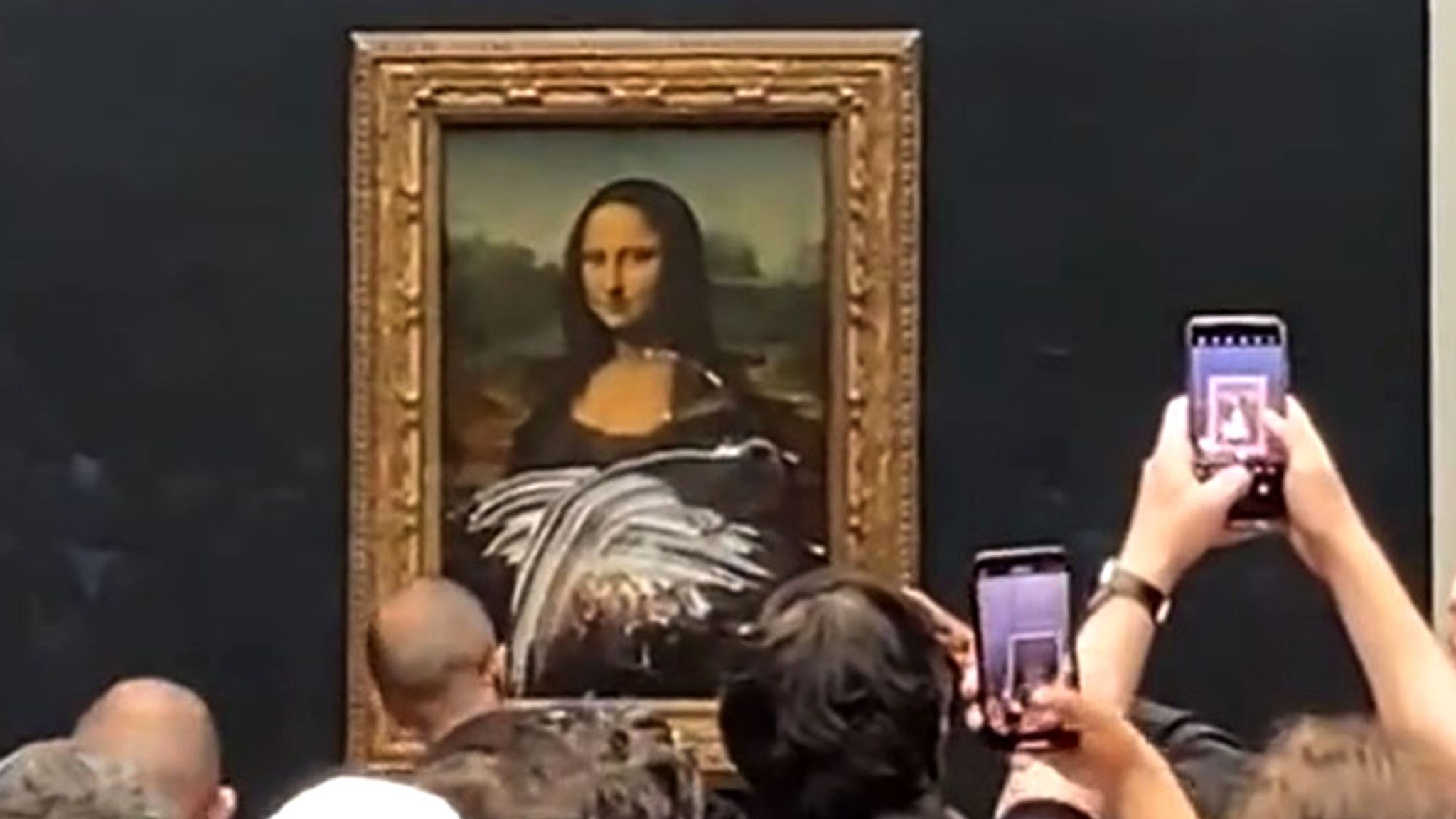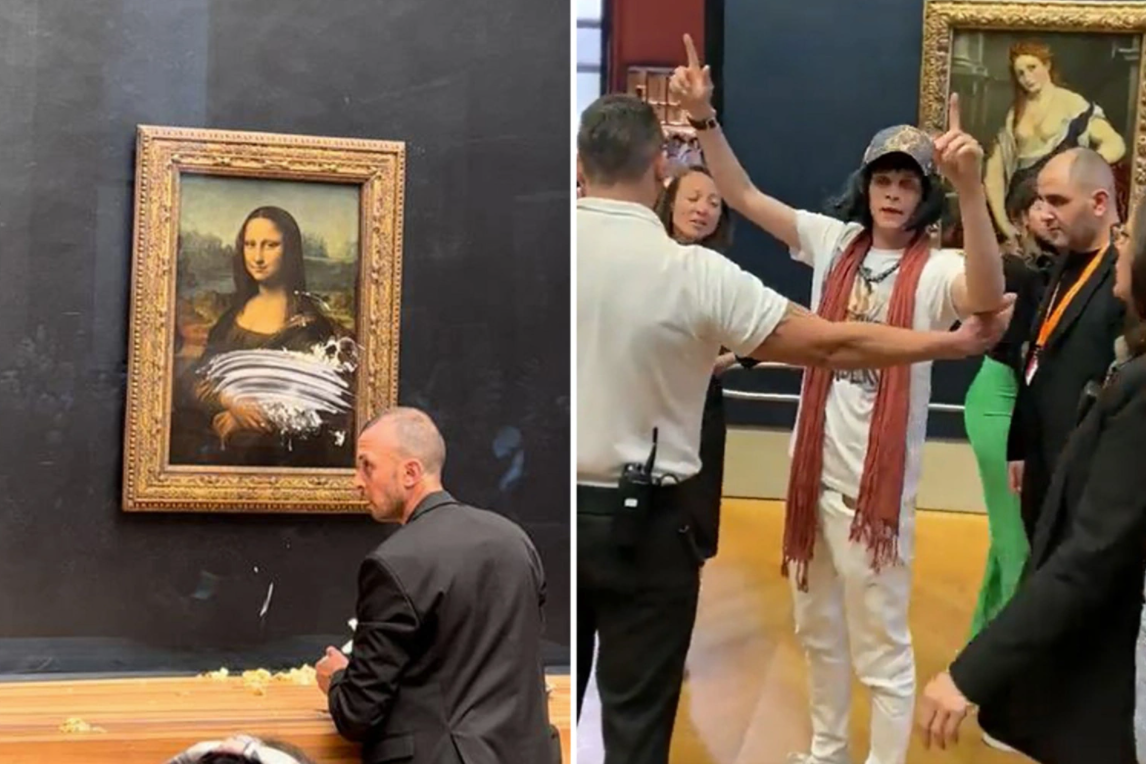
They make brief eye contact in the Louvre. She smirks at the tourists photographing her. He disguises himself in the audience (as an older woman in a wheelchair) until he stands up, steps over the security barriers and throws cake all over her. The shocked crowd gasps and films the spectacle.
On 29 May, Leonardo Da Vinci’s Mona Lisa, arguably the world’s most famous piece of art, was covered in buttercream by an unnamed climate activist. Before being dragged away by security, arrested and placed in psychiatric care, the activist shouted: “All the artists tell you [to] think about the Earth! All artists think about the Earth! That’s why I did this! Think about the planet!”
It wouldn’t be a stretch to describe this incident as a performance piece that accurately captures the surreal moment we find ourselves in. A brazen act that could be seen as a rational response to humans destroying our own habitat is instead criminalised and treated as a psychotic breakdown by an art world historically propped up by oil and gas sponsors.
“The Mona Lisa is encased in bulletproof glass, so the chances of it being damaged by mere frosting were minimal”
The protester must have been desperate to make the world listen in the face of mass indifference to rising temperatures. The planet has already passed the warming threshold of 1.1° Celsius, and unless there is mass intervention, things are set to worsen, fast. Scientists are now predicting warming of 1.5°C by the 2030s, which would decimate Pacific Islands and other low-lying territories.
As well as this, we are currently living through the planets’s sixth mass extinction event. The latest Intergovernmental Panel on Climate Change (IPCC) report stated that colonialism has exacerbated the effects of climate change, which is now disproportionately affecting marginalised communities across the world, and vast swathes of the Global South.
And yet the absurdity of our situation is only heightened by people’s responses to the cake thrower. Online, people posted statements such as “NOT the way to bring attention to climate change. Classic works of art like the Mona Lisa are a gift [to] all mankind. We need to protect great art from all over the world” and “That’s not funny nor is it okay. That would’ve been a piece of art history wrecked.”
The irony is twofold. First, the Mona Lisa is encased in bulletproof glass, so the chances of it being damaged by mere frosting were minimal. Second, few paintings, including the Mona Lisa, are going to survive unmitigated environmental collapse. There’s no art on a dead planet, after all.
“Few paintings, including the Mona Lisa, are going to survive unmitigated environmental collapse. There’s no art on a dead planet”
While security staff guard the painting at all times, the Louvre continues its relationship with TotalEnergies. The energy giant regularly helps the gallery secure major acquisitions, and has led to dramatic climate protests at the Louvre.
In 2015, protesters poured molasses on the museum’s marble floor to mimic an oil spill, while in 2018, activists orchestrated a ‘die in’ in front of Géricault’s The Raft of the Medusa, where they dropped to the floor mimicking the contorted figures in the impassioned painting. “Tar sands. Drying up of rivers. Emission of greenhouse gases. Indigenous populations threatened. The Louvre supports Total!” they chanted.
The latest plea for public attention in front of the smiling 16th-century icon looks unlikely to be the last. As the environmental situation becomes ever more urgent, more renowned art institutions and their dubious commercial arms will surely be dragged into disruptive protests. Unless, of course, they were to embark on a much-needed period of self-reflection.
“The art world is funded by the very multinational corporations and billionaires causing climate destruction”
The list of innovative artistic responses to the climate crisis is endless. Tan Zi Xi is turning ocean waste into extraordinary installations. Liam Young proposes letting the world recover while 10 billion people move into a single city. Olafur Eliasson places melting ice in public spaces. Design collectives imagine what post-Anthropocene dinner parties would look like. Allison Janae Hamilton uses her interdisciplinary practice to interrogate our relationship with changing landscapes.
At the same time, there is a deep chasm between such climate artists and the contradictory practices of an art world seemingly fuelled by decadence; in 2021, Dom Pérignon charged $30,000 for a service which would deliver 33 vintage bottles and caviar to the anchored boats of those attending Art Basel Miami Beach, as Zoë Lescaze reported in the New York Times. Not only does the sector produce thousands of tons of carbon dioxide in air transport and copious amounts of packaging waste during art fairs as well as temporary exhibitions, it is also funded by the very multinational corporations and billionaires causing climate destruction.

Scratch beneath the surface, and the contradictions pop up everywhere. The fountain by the entrance of the Metropolitan Museum of Art bears David Koch’s name, a billionaire who actively financed climate denialism up until his death in 2019. One of MoMA’s trustees has a husband who sits on the advisory board of the Barrick Gold Corporation, which mines gold and copper in 13 countries, most of which are in the Global South.
“More drastic action is needed to denounce the dirty money that funds the art world, and direct audiences towards hope as well as action”
The good news is that organisations such as the Gallery Climate Coalition and Julie’s Bicycle are building tools to guide art institutions in dealing with the climate crisis while also holding them to account. However, more drastic action is needed to denounce the dirty money that funds the art world, and direct audiences towards hope as well as action, before it’s too late.
Art institutions cannot continue hiding behind their annual climate-themed exhibitions to absolve themselves of responsibility to the planet. If preserving cultural masterpieces, like the 500-year-old Mona Lisa is truly a priority, they must finally lift the veil on this unglamorous, uncomfortable and inevitable truth: they are not only not doing enough to save the planet, they are actively complicit in destroying it.
The environmental footprint of the art world may be less than that of the agriculture or energy sectors, but that does not mean that they should rest easy. The arts have a significant cultural impact and powerful influence on the ways in which we see the world. They have a responsibility to not only imagine but to build a better and more just future.
Diyora Shadijanova is a multimedia journalist and climate editor at gal-dem






